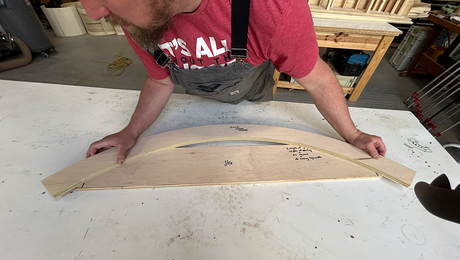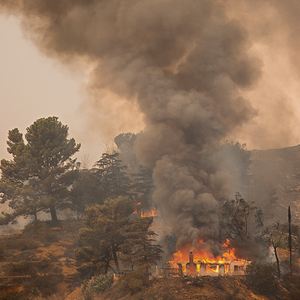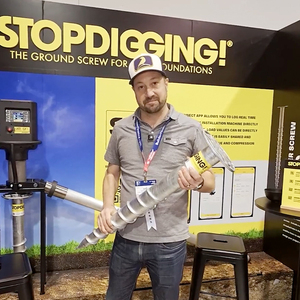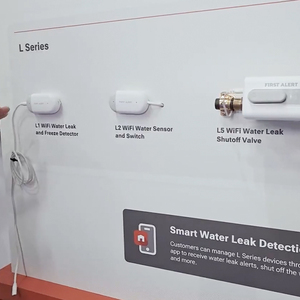IAQ and make-up air
I am a sometimes-carpenter/mostly heavy equipment operator. My wife and I are building a home. The walls are up, roof on, windows in, with temporary doors.
The climate is 7500 HDD (west-central Wyoming at the eastern foot of the Rockies ~ 6100′ elev.), 330 sunny days per year, low year-round humidity.
The house is single story (15,000 cu.ft) dry-stack CMU (all cores filled) and partially bermed (15% +/-). The wall insulation is 3″ XPS on the exterior with ¾” stucco over it and ¾” stucco on the interior. The ceiling will be air-sealed with 14″ cellulose, which will connect to the exterior insulation via raised heel trusses and insulation dams above the soffit. The heating is partially passive solar (direct gain ~ estimated at 35% SSF) and a floating radiant slab (sealed combustion, modulating condensing-boiler and indirect fired DHW). Cooling will be passive (humidification/dehumidification aren’t necessary). Exhaust fans are presently planed at 100cfm in bathroom, 160-200cfm on electric dryer, and a 200-300cfm range hood.
I’ve read many posts here (also at JLC & HVAC-talk), related information from various building and manufacturer web sites on the topics of IAQ and make-up air (also ACH and HRV’s), and had conversations with some of these folks. I’m trying to understand what the ACH for this house are likely to be, whether ventilation and/or make-up air are necessary, and, primarily, different ways to deal with them if they are necessary.
Right now, my thought is a HRV may be overkill for ventilation and passive make-up air (possibly un-tempered) for the fans seems necessary. I don’t know that is right and I don’t know what to do about it if it is or isn’t.
I would appreciate all help any of you have to offer in figuring out a simple, functional system for this house.
Mike Krall



















Replies
Right now, my thought is a HRV may be overkill for ventilation and passive make-up air (possibly un-tempered) for the fans seems necessary. I don't know that is right and I don't know what to do about it if it is or isn't.
The point is air quality, not heating. If your house is tight, and cmu almost has to be, your indoor air quality will be poor without frequent air changes. I followed the, at the time, Canadian standard of .5 ACH. It's not unusual for visitors to mention our air quality, compared to what they were accustomed to at home.
Furthermore, if you positively pressurize the house all leaks will go out, making it much more comfortable. HRV's merely recapture a majority of the heat, summer and winter, to make the house more comfortable. Your exhaust fans can find make-up air from leaks, but they won't give you good quality indoor air 24/365.
15k cu ft only comes to 125 cfm at .5 ACH. Any ductwork will be fine. Get on with it. I usually get fans from Surplus Center. Stay away from the squirrel cages. Muffins work better. Size the intake larger than the exhaust.
PAHS Designer/Builder- Bury it!
Thank you for the respose, Tom.
I see the part about make-up air for the exhaust fans by infiltration (@ 0.2 to 0.3 ACH for structure tightness on 15k cu.ft. for 300 to 450 cfm available). If this house isn't much tighter than that, it works.
Somewhere I got the idea a person was trying to have neutral pressure so, whatever the structure ACH, there was no in/exfiltration. If that is so, what size of intake accounts for the make-up air for the exhaust fans mentioned? Needs tempering in this climate? Passive? Back dampered?
I don't understand the ventilation system you outlined. Is it a 125cfm HRV, or...? What does having a larger intake cause?
I've come across discussion about home-designed and built tempering systems for ventilation air (David Thomas, for one). Is that a viable or necessary solution in this climate?
Mike Krall
I'll second the question as I am looking at doing a similar HVAC set-up (RFH, sealed combustion boiler, vent hood over range) but with spray foam insulation. My understanding of the foam is that it creates a rather airtight house if installed correctly. I was planning on a simple HRV set up but have read (here and elsewhere) that I shouldn't count on it to equalize and handle the make up air problem created by a vent hood and a clothes dryer. Is that correct? Having some other type of make-up air port that doesn't tie-in to the HRV would seem to defeat one of the main functions of the HRV system. Surely I am missing something.
-Rich
Hmmm.... Looks like what I tried to post last night didn't make it. One more try.....
Somewhere I got the idea a person was trying to have neutral pressure so, whatever the structure ACH, there was no in/exfiltration. If that is so, what size of intake accounts for the make-up air for the exhaust fans mentioned? Needs tempering in this climate? Passive? Back dampered?
How you could get neutral pressure with occasional exhaust fan operation, not to mention wind blowing, is beyond me. Leaks happen. What I was suggesting was to ensure that all leaks go out. Your exhaust fan usage may temporarily change that, but not for very long.
I don't understand the ventilation system you outlined. Is it a 125cfm HRV, or...? What does having a larger intake cause?
125cfm is what you need to get .5ACH in 15k cu ft. HRV, or not, is up to you. I wouldn't do without, considering how easy to build/install they are. Commercial HRVs usually have equal sized intake/exhaust fans, something I wouldn't do. A larger intake fan will at least partially provide make-up for your other exhaust fans while providing the pressure to make your air leaks go out during normal operation.
I've come across discussion about home-designed and built tempering systems for ventilation air (David Thomas, for one). Is that a viable or necessary solution in this climate?
David does numbers better than I do. As far as I can tell, all houses in climates where the windows are sometimes closed will do better with an air system. Well, assuming we aren't talking about extremely leaky ones. Lots of old farmhouses around here with no need. With the small cost, both installation and operation, I see no reason to do without. As very few houses here are built with one, the occupants suffer. Our code enforcers accept an operable window as satisfying ventilation requirements, even though open windows would be common only a few months/yr here.
Attached is an old Pop Science article on building an exchanger that I used. Design is very similar to a Lossnay. I used corrugated aluminum roofing rather than the plastic exchanger parts. Remarkably effective.
PAHS Designer/Builder- Bury it!
Mike, it would be helpful to your utility bills if you could supply the clothes dryer with its own make up air, like a partially opened window in a utility room. Weather strip the utility room door etc, so that the dryer is out side the house air envelope. That way you will not be emptying the house of conditioned air every 75 minutes the dryer is operating. Also, the utility room does not need a conditioned air supply vent, as the dryer simply blows it out side when running, and when not running the conditioned air stream pulls lint, dust and humidity into the rest of the house. Paul
Sorry for no responses... I've been on the road since early yesterday morning.
Rich -- My understanding is the make-up air comes in one way or another (leaks or specifically-provided) and has to be heated/cooled. I don't know in what climates warming specifically-provided make-air makes sense.
Tom -- On neutral pressure... I thought pressure differences between inside and outside generally were not high. And a passive intake (back draft dampered and sized properly for the exhaust fans) would allow a house to remain at neutral pressure most of the time, even with fans running?
Paul -- I'm not getting the part about the tempered air pulling lint, humidity, etc. in, would you clear me up on that, please?
Mike Krall
And a passive intake (back draft dampered and sized properly for the exhaust fans) would allow a house to remain at neutral pressure most of the time, even with fans running?
Sounds right. We have no problem relying on leaks and a little pressure. How much effort you put in probably depends on how much you run your exhaust fans.
Pressure differences are very slight. Better if you can open the doors easily. <G> Our place is tight enough that opening one of our (large~ 27 sq ft) doors will shake the interior frame walls in this concrete house. Another reason I wanted higher inside pressure was this is a moderate risk radon area.PAHS Designer/Builder- Bury it!
Tom,
The exhaust fans won't run much, so maybe the make-up air solution that was in a short JLC article this past year would do (4", back draft dampered, in low, up, and out high and behind the refridgerator ~ probably 10' of duct). How does that sound to you?
I guess a person could temper the make-up air using David Thomas's idea of hooking two 4' fin tubes together and putting them in the duct but I don't know how that would work in this situation because he was using it to add heat to incoming air after it passed through the HRV's heat exchanger.
If David's fin tube system would work for this (and not cost an arm to build, control and run, either), maybe a person could use the idea in the separate ACH system for tempering that air, too?
I guess I still don't understand what level of necessity there is for tempering either of the air sources in this 7500 HDD climate. How do you think about that on a "your-going-to-heat-it-one-way-or-the-other" basis?
Mike Krall
Edited 5/9/2004 5:29 pm ET by mkrall
Hey Mike, looks like my ISP's working better today. My take is that you're creating several systems instead of using one, as I do. Certainly you can make more systems fine tuned to better handle your air loads, but at what cost? I could, for instance, have separate heat exchangers for each exhaust fan, but for the minimal running time, it doesn't seem reasonable. So I hedge my bet with pressurization.
I have 20k cu ft and don't notice any inward air leaks when an exhaust fan's going. Doesn't mean I don't have any, as in time (depending on the cfm of the exhaust fan) it will happen. But it hasn't been a problem to solve. Calculable, I'm sure, but not important for me.
At 7500 you far exceed our 4166 degree-days. A balancing factor is our ac climate. Our air heat exchange system does the same thing summers as during our relatively mild winters, but in reverse direction. Meaning I don't have your heat load, but do have at least as many months of heat exchange. We have no need of ac, but if we were bringing in untempered summer air we would.
This comes to the heart of your How do you think about that on a "your-going-to-heat-it-one-way-or-the-other" basis? What we've found is a system that works admirably without any need for additional small, occasional use, systems.
To maybe answer your question, I see no need for additional systems, but I didn't read the JLC article. With our heat exchanger as efficient as it is, all I wanted was to preclude untempered outside air from entering. I've pretty well done that.
Our house is a very different design from yours but our air system has performed so well that the next place, just out of the ground, will get the same thing. Well, that's not quite right, the indoor pool will have its own system, but that's due to humidity.
Last year this house underwent a 10° annual temp swing, 65° to 75° without any added heat or ac. The air system is a large part of that success, all the while giving us the best quality indoor air I've experienced. I'm still tinkering, like adding the heat pump water heater to get better performance, but see no reason to change my general plan. PAHS Designer/Builder- Bury it!
I am building a home with spray foam insulation and various other tricks to make it very tight. I am going with RecoupAerator ERV's, which can be set for neutral or 3 different amounts of positive pressure. That's especially important if you have a wood stove or fireplace. Even though our fireplace insert will be airtight with an outside air source, if there was negative inside pressure, as soon as you went to add a log, smoke would pour in through the open door. I'll run my ERVs constantly with the furnace air handlers running at a very low speed(they are infinitely-variable speed motors). At 50 CFM, I will get one air exchange every 3 to 4 hours. Yes, you ARE going to heat it one way or another, but why heat it twice? If you can get fresh air in, and stale air out, while retaining 90+% of your heat, why not do it?
Xman,
In the end, I may go with an HRV. I want to make sure I understand the problem first, then look at the solutions people have worked with. I'd like to find a simple, functional system.
The way I see HRV's is: The units cost a lot, the running of them costs more for the two fans than the one of some other systems, they have to be maintained well, there can be freeze-up/defrost problems, they seem to generally be noisier than fans a person could use in alternative systems, most don't provide make-up air and those that do, cost more to run the intake fan at a higher cfm and may not provide the amount necessary (200 cfm dryer, 100 cfm bath fan, 200/400/600 cfm rangehood?) plus the incoming air, when on positive-pressure-intake, will be cooler than it would be when on balanced intake/exhaust and will tend to go out by the path of least resistence which, in a tight house, would be the exhaust stacks near the ceiling where the warmest air is.
My understanding is, an HRV doesn't make economic sense unless the climate is extremely cold (not that economics is the be-all, end-all for decision making). They may do the best job of house ventilation but other systems may do the job well.
Mike Krall
Mike:
Those are all very valid points. In my case, economics weren't the issue at all--death by asphyxiation was the primary concern! That is a partial joke, but fresh air was the concern. That AirCycler that you can get from Aprilaire is a good idea, with a controlled amount of time to run in fresh air, and it's cheap. Its a motorized damper that can be set for X number of minutes/hour. For instance, you set it for a total of 30 minutes per hour. If your furnace is on for 15, it will kick on the air handler for 15 more minutes to deliver fresh air. Simple and effective, but no recovery of heat, and no "bad air out"(although no doubt it DOES go out).
"...supply the clothes dryer with its own make up air, like a partially opened window in a utility room."
I wonder - Why is it no one has made a clothes dryer that pulls in outside air? Seems like it would make good sense. If we can do it for a furnace, why not a dryer?
The clothes might have more of that "fresh air" smell, like they were hung out on a clothes line.
Just wondering...People forget how fast you did a job, but they remember how well you did it. [Howard W. Newton]
Boss, you are correct. There are numerous fairly simple improvements that would save a bundle of $$ if just applied to our homes.
Here is one for you: I installed a drain under my refrigerator for the defrosted condensate. Why freeze moisture out of the air, then melt it and blow air over the scum tray to evaporate the water back into the home for the A/C to then extract? Also provides hidden drain to carry away water in case we have an ice maker water line break. Is not rocket surgery. PaulEnergy Consultant and author of Practical Energy Cost Reduction for the Home